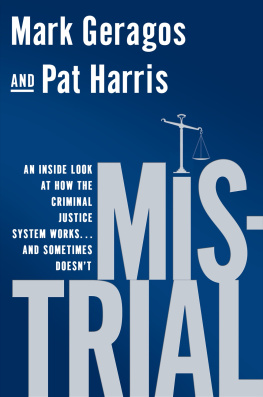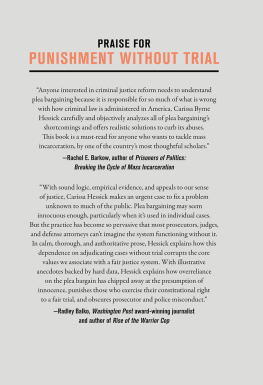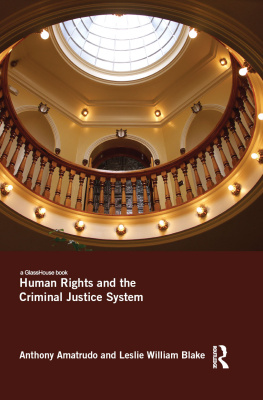Kafkas Law
The Trial and American Criminal Justice
ROBERT P. BURNS
THE UNIVERSITY OF CHICAGO PRESS
CHICAGO AND LONDON
ROBERT P. BURNS is professor at Northwestern University School of Law. He is the author of The Death of the American Trial, also published by the University of Chicago Press.
The University of Chicago Press, Chicago 60637
The University of Chicago Press, Ltd., London
2014 by The University of Chicago
All rights reserved. Published 2014.
Printed in the United States of America
23 22 21 20 19 18 17 16 15 14 1 2 3 4 5
ISBN-13: 978-0-226-16747-3 (cloth)
ISBN-13: 978-0-226-16750-3 (e-book)
DOI: 10.7208/chicago/9780226167503.001.0001
Library of Congress Cataloging-in-Publication Data
Burns, Robert P., 1947 author.
Kafkas law : The Trial and American criminal justice / Robert P. Burns.
p. ; cm
Includes bibliographical references and index.
ISBN 978-0-226-16747-3 (cloth : alkaline paper) ISBN 978-0-226-16750-3 (e-book)
1. Criminal procedureUnited States. 2. Criminal justice, Administration ofUnited States. 3. Kafka, Franz, 18831924. Prozess. 4. Law in literature. I. Title.
KF9619.B875 2014
345.73'05dc23
2013048752
 This paper meets the requirements of ANSI/NISO Z39.481992 (Permanence of Paper).
This paper meets the requirements of ANSI/NISO Z39.481992 (Permanence of Paper).
Contents
Preface
In this book, I look at a system with which we seem to be very familiar through a lens that is, to most of us, quite unfamiliar. We are all exposed to the workings of our criminal justice system. One wag commented that a future civilization attempting to reconstruct contemporary society from its television programs would conclude that half or more of our citizens were either detectives or lawyers. (The rest were emergency room doctors.) Crime programs are ubiquitous, including all the iterations of Law and Order and CSI. Some prosecutors have even complained that those programs were changing jury behavior, making convictions harder to obtain. Cable news is filled with reports and punditry surrounding crimes and criminal cases. Some shows, former prosecutor Nancy Graces, for example, are devoted exclusively to crimes and the prosecutions of crimes. Then there are the almost daily crime stories in our newspapers. And the gavel-to-gavel televising of some very high profile criminal trials, the George Zimmerman case, for example, followed by extensive commentary.
It seems that we know this system very well. Alas, this is not so. The actual workings of our machinery of criminal justice are only dimly perceived. To understand it concretely, I argue, it helps to see it through the eyes of one particular artist. Indeed, I believe that many of its gears, nuts, and bolts become clearest when viewed through the eyes of Franz Kafka, author, most relevantly, of The Trial. The perspective of a foreign visitor often allows us to see what we can see least well, that which is closest to us.
Kafka was born in 1883 in Prague, then a predominantly Czech city with a large German population, in the Austro-Hungarian Empire.ship of a successful dry-goods story in the city. Kafka celebrated his bar mitzvah when he was thirteen, but received a classical German education and entered the German Charles Ferdinand University in Prague, earning a doctorate in law. He moved in literary circles in the city and began limited publication of some short works. He practiced law for private entities for a couple years and then began his major professional work at the Workers Accident Insurance Company, which lasted from 1908 until just two years before his death from tuberculosis in 1924. He traveled through Europe during the second decade of the twentieth century, attending lectures and readings by some of the eras most important writers and thinkers. His employers insisted that he was too valuable to release into the army for the Great War, which had begun in 1914. He wrote The Trial in 191415. He struggled about the decision to marry but remained a bachelor, though he had a number of intimate relationships. He was instrumental in establishing a hospital for injured war veterans and continued to publish short stories, but never published any one of his three novels. All were published, after aggressive editing by his friend Max Brod, after his death and despite what may have been a halfhearted instruction that they be destroyed.
Kafka was a genius. W. H. Auden said that Kafka is to our era what Dante and Shakespeare are to theirs, the writer who most comprehensively shows us what we are becoming. His genius was to address institutions and practices as problems specifically for modern people with modern political, psychological, and religious sensibilities. He was also a lawyer who worked for years for a semigovernmental organization that struggled to regulate the new and newly dangerous industries and factories that had grown up in Central Europe and also paid out disability benefits to workers maimed in their machines. (One of his most famous stories, In the Penal Colony, describes a horrendous execution machine patterned on the machines he knew all too well.) Kafka understood bureaucracy and law from the inside. He was a very good lawyer. He was one of the originators of a perspective that one commentator called organizational gothic, an understanding that the locus of evil in modern societies often lies within the gears of its bureaucracies. His anticipation of some of the law-ways of the Third Reich, for example, was uncanny.
This book examines aspects of the American criminal justice system through the lens that Kafka provided us in The Trial. It assumes no familiarity with Kafka or with The Trial. I provide in the first two chapters all that is necessary to the later argument. Although the novel ends grimly, it is often very funny. It satirizes dominance. One of Kafkas contemporaries observed that humor can add immeasurably to the clarity of thought. I hope that greater clarity about what we are doing in our criminal justice system will emerge from my efforts here.
I am grateful to Mary Burns and Locke Bowman, both of whom carefully read the manuscript and whose suggestions greatly improved it. I am grateful as well to the Presss anonymous readers who offered both appreciation of the work and positive, forward-looking criticism. And John Tryneski, the Presss executive editor for legal studies, was again a joy to work with. Our discussions often helped me clarify and improve my thinking. Short sections of this book have appeared in earlier forms in the William and Mary Law Review and the Georgia Law Review.
Introduction
The Trial is actually closer to reality than fantasy as far as the clients perception of the system. Its supposed to be a fantastic allegory, but its reality. Its very important that lawyers read it and understand this.Justice Anthony Kennedy
In 1994, David Saracenoin his denials, they would make sure he went to jail, where, they said, he would not survive:
It would be like throwing a lamb to the lions, they told him. He would be raped by a big black nigger. Terrified, and believing that this was a done deal, Saraceno started to shake uncontrollably. He started to see spots; twice he felt like he was going to pass out. He told the detectives that he felt nauseous and asked them if he could receive medical attention, but they denied his request and responded that his feelings of nausea were really just feelings of guilt and would pass once he confessed.... As he had throughout earlier portions of the interrogation, Saraceno cried, this time uncontrollably.
Eventually, Saraceno asked the detectives, Do you want me to lie? Is that what you are telling me I should do? One of the detectives responded that Saraceno should do whatever he felt was necessary and right. At this point, Saraceno began fabricating a story, repeating the details the detectives had told him and agreeing to their suggestion of the facts.
Next page




 This paper meets the requirements of ANSI/NISO Z39.481992 (Permanence of Paper).
This paper meets the requirements of ANSI/NISO Z39.481992 (Permanence of Paper).